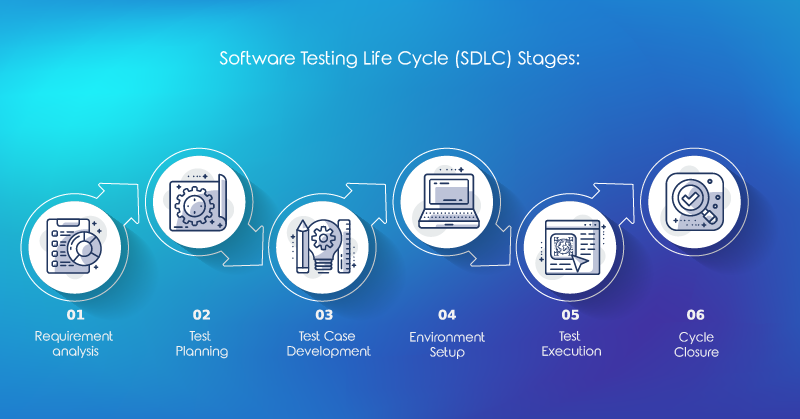Question: What is SOFTWARE TESTING LIFE CYCLE (STLC)
The software testing life cycle is a sequence of specific activities conducted during the testing process to ensure software quality goals are met. STLC involves both verification and validation activities. Contrary to popular belief, Software Testing is not just a single/isolate activity, i.e. testing. It consists of a series of activities carried out methodologically to help certify your software product. STLC stands for Software Testing Life Cycle.

Below are the phases of STLC:
- Requirement Analysis
- Test Planning
- Test case development
- Test Environment setup
- Test Execution
- Test Cycle closure
Each of these stages has a definite Entry and Exit criteria, Activities & Deliverables associated with it.
You have Entry and Exit Criteria for all levels in the Software Testing Life Cycle (STLC)
What is Entry and Exit Criteria?
- Entry Criteria: Entry Criteria gives the prerequisite items that must be completed before testing can begin.
- Exit Criteria: Exit Criteria defines the items that must be completed before testing can be concluded
In an Ideal world, you will not enter the next stage until the exit criteria for the previous stage is met. But practically this is not always possible. So for this tutorial, we will focus on activities and deliverables for the different stages in STLC life cycle. Let’s look into them in detail.
Requirement Analysis
During this phase, test team studies the requirements from a testing point of view to identify the testable requirements.
The QA team may interact with various stakeholders (Client, Business Analyst, Technical Leads, System Architects etc) to understand the requirements in detail.
Requirements could be either Functional (defining what the software must do) or Non Functional (defining system performance /security availability). Automation feasibility for the given testing project is also done in this stage.
Activities
- Identify types of tests to be performed.
- Gather details about testing priorities and focus.
- Prepare Requirement Traceability Matrix (RTM).
- Identify test environment details where testing is supposed to be carried out.
- Automation feasibility analysis (if required).
Deliverables
- RTM
- Automation feasibility report. (if applicable)
Test Planning
Typically, in this stage, a Senior QA manager will determine effort and cost estimates for the project and would prepare and finalize the Test Plan. In this phase, Test Strategy is also determined.
Activities
- Preparation of test plan/strategy document for various types of testing
- Test tool selection
- Test effort estimation
- Resource planning and determining roles and responsibilities.
- Training requirement
Deliverables
- Test plan /strategy document.
- Effort estimation document.
Test Case Development
This phase involves the creation, verification and rework of test cases & test scripts. Test data, is identified/created and is reviewed and then reworked as well.
Activities
- Create test cases, automation scripts (if applicable)
- Review and baseline test cases and scripts
- Create test data (If Test Environment is available)
Deliverables
- Test cases/scripts
- Test data
Test Environment Setup
Test environment decides the software and hardware conditions under which a work product is tested. Test environment set-up is one of the critical aspects of testing process and can be done in parallel with Test Case Development Stage. Test team may not be involved in this activity if the customer/development team provides the test environment in which case the test team is required to do a readiness check (smoke testing) of the given environment.
Activities
- Understand the required architecture, environment set-up and prepare hardware and software requirement list for the Test Environment.
- Setup test Environment and test data
- Perform smoke test on the build






